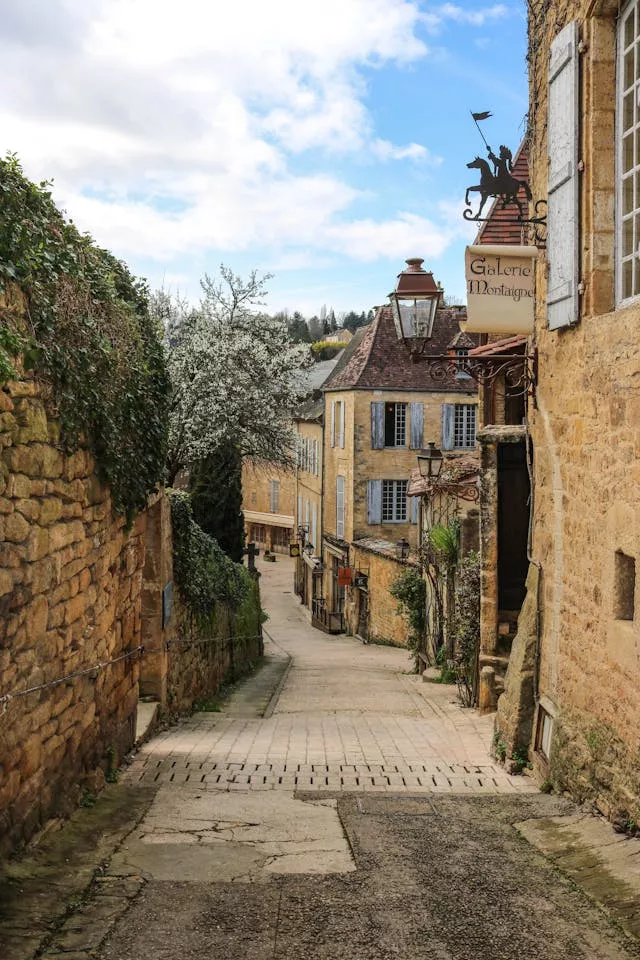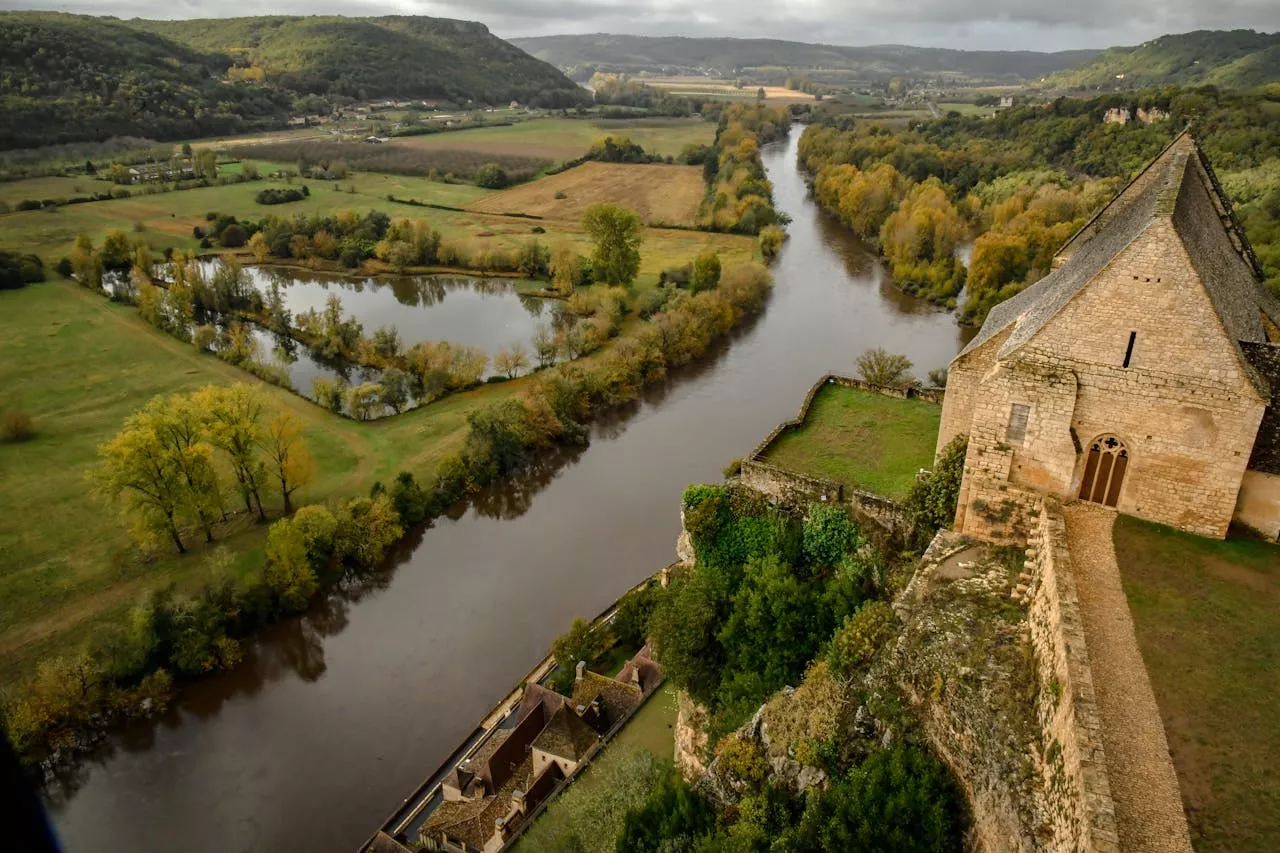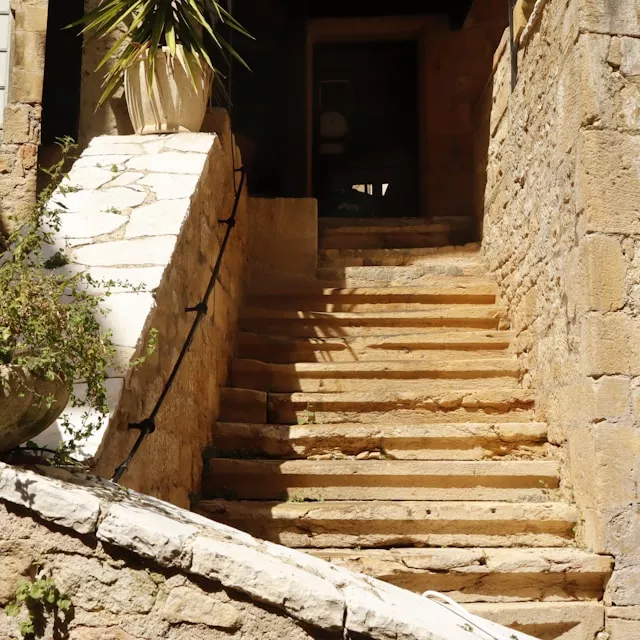A Living Medieval Masterpiece
The town's remarkable preservation isn't accidental. Designated as a protected historic sector in 1962, Sarlat became France's first town saved under the Malraux Law, which incentivized restoration of historic buildings. Today, the Vieille Ville (Old Town) showcases over 65 classified historic monuments within less than one square kilometre, creating an architectural density that feels almost overwhelming in its beauty.

Golden Stone and Medieval Glory
Sarlat's signature honey-coloured limestone bathes everything in warm, golden light that changes throughout the day. Morning sun transforms facades into glowing amber, while sunset creates dramatic shadows that accentuate every carved detail, Gothic window, and Renaissance courtyard. This distinctive stone, quarried locally for centuries, gives Sarlat its cohesive architectural harmony that makes wandering the streets feel like moving through a living painting.

The town reached its golden age during the 13th-16th centuries when it served as an important religious and commercial centre. Wealthy merchants and clergy built grand townhouses adorned with towers, turrets, and elaborate carvings that still define Sarlat's skyline. The Maison de La Boétie, birthplace of the famous Renaissance humanist, exemplifies this period's architectural ambition with its ornate Italian Renaissance facade that seems impossibly sophisticated for a provincial French town.
The Market: Sarlat's Beating Heart
If Sarlat has a soul, it's found at the Saturday morning market, arguably the finest traditional market in all of France. Every Saturday, the historic center transforms into a sprawling open-air feast where local producers sell everything that makes the Dordogne legendary: foie gras, truffles, walnuts, strawberries, cheeses, and wines.
The market isn't a tourist attraction—it's where locals do their weekly shopping, creating an authentic atmosphere that feels participatory rather than performative. Farmers arrive before dawn to arrange displays of seasonal produce picked hours earlier. Foie gras producers offer tastes from their own ducks and geese. Cheese vendors cut samples from massive wheels of local tomme. The energy, aromas, and animated conversations create a sensory experience that captures everything magical about French market culture.
Beyond Saturday's grand spectacle, Sarlat hosts smaller markets three times weekly (Wednesday and Sunday mornings), plus special evening markets during summer when the medieval squares fill with artisan food stalls, local wines, and live music that continues past midnight.
Culinary Capital of Périgord
Sarlat serves as the gastronomic heart of Périgord, the historic name for the Dordogne region famous for producing France's most luxurious ingredients. The town's restaurants range from Michelin-starred establishments to humble bistros, all united by their commitment to showcasing local terroir through traditional recipes that have barely changed in centuries.
Foie gras reigns supreme here, prepared dozens of ways from classic terrine to seared escalopes with fig compote. The Dordogne produces roughly 30% of France's foie gras, and Sarlat's markets and restaurants offer it at quality and prices impossible to find elsewhere. Local preparation methods, passed through generations, create subtle flavour variations that connoisseurs can identify by village. To learn more about this and other French food delicacies, explore the rich traditions that make French cuisine legendary.

Black truffles from the surrounding oak forests appear on winter menus, shaved over eggs, folded into omelets, or perfuming simple pasta dishes with their intoxicating earthiness. The nearby truffle markets in January and February draw chefs and gourmands from across Europe seeking these "black diamonds" at their source.
Walnuts from Périgord hold protected designation status (AOP), prized for their delicate flavour and perfect texture. They appear everywhere—in salads, pressed into oil, ground into cakes, or simply cracked fresh at market stalls. The annual walnut festival each October celebrates the harvest with tastings, demonstrations, and competitions.
Architectural Treasures Worth Discovering
While Sarlat's entire old town deserves exploration, several landmarks stand out as essential stops that reveal different layers of the town's rich history.
Cathédrale Saint-Sacerdos anchors the historic center with its unusual architectural blend spanning five centuries. The mix of Romanesque and Gothic elements reflects the cathedral's long construction period, while its bulbous 18th-century bell tower provides an unexpected baroque flourish. Inside, the organ—one of France's finest—fills the stone interior with music during summer concerts.
The mysterious Lanterne des Morts (Lantern of the Dead) rises behind the cathedral—a rare 12th-century conical tower whose original purpose remains debated. Some historians believe it served as a funerary monument, others as a memorial to Saint Bernard's 1147 visit. Whatever its origin, this enigmatic stone sentinel has become one of Sarlat's most photographed landmarks.
Place de la Liberté serves as Sarlat's living room—the main square where markets happen, cafés spill onto cobblestones, and locals gather for evening conversations. The square's asymmetrical medieval charm makes it endlessly photogenic, especially during the Saturday market when it overflows with colourful stalls and animated crowds.
The narrow Rue de la Salamandre exemplifies medieval urban planning at its most atmospheric. Buildings lean toward each other across the tiny street, their upper floors nearly touching, creating a tunnel-like effect that transports visitors straight to the Middle Ages. The street takes its name from the carved salamanders—symbols of François I—adorning several facades.
Beyond the Town Walls
Sarlat's strategic location makes it the perfect base for exploring the Dordogne Valley's countless attractions. The surrounding countryside offers prehistoric caves, riverside châteaux, hilltop villages, and scenic river valleys that rank among France's most beautiful landscapes.

The Dordogne River winds through dramatic limestone cliffs and pastoral valleys dotted with medieval castles. Traditional flat-bottomed boats called gabare offer peaceful river journeys past sheer rock faces, medieval fortresses, and riverside villages that seem unchanged since the Hundred Years' War.
Château country begins just minutes from Sarlat, where feudal fortresses crown nearly every hilltop. The "Five Castles" of the Dordogne—Beynac, Castelnaud, Marqueyssac, Fayrac, and Château des Milandes—represent different architectural styles and historical periods, from severe medieval fortresses to elegant Renaissance residences. Many offer guided tours, falconry demonstrations, and spectacular valley views.
The Vézère Valley northeast of Sarlat contains humanity's most important prehistoric sites, including the famous Lascaux caves. While the original Lascaux remains closed to protect 17,000-year-old paintings, the Lascaux IV replica offers an extraordinary experience that faithfully reproduces every detail. Nearby Font-de-Gaume still allows limited visits to authentic cave paintings, providing rare direct contact with Paleolithic art.
Plus beaux villages (most beautiful villages) surround Sarlat like scattered jewels. La Roque-Gageac clings impossibly to cliff faces above the Dordogne. Domme offers panoramic valley views from its hilltop bastide. Beynac-et-Cazenac cascades down slopes beneath its imposing castle. These villages, many designated among France's official "most beautiful," provide perfect day trip destinations.
Seasonal Rhythms and Festival Spirit
Sarlat's character changes dramatically with the seasons, each period offering unique appeal and different experiences for visitors seeking to understand the town's authentic rhythms.
Summer (June-August) brings the town fully to life with evening markets every Wednesday and Saturday night. These marchés nocturnes transform medieval squares into festive outdoor dining rooms where visitors buy prepared foods from various stalls then share communal tables under the stars. Live music, flowing wine, and warm summer nights create magical atmospheres that extend well past midnight.

The Festival des Jeux du Théâtre each July and August fills the town with street performers, musicians, and theatrical productions performed in historic courtyards and squares. Sarlat becomes an open-air stage where professional and amateur troupes present everything from classical French theatre to contemporary comedy.
Autumn (September-November) showcases the Dordogne at its most beautiful and delicious. Walnut harvests begin, mushrooms appear in markets and on menus, and the surrounding forests blaze with fall colour. The Fest'Oie (Goose Festival) celebrates the region's most important bird with tastings, demonstrations, and competitions that attract thousands of foie gras enthusiasts.
Winter (December-February) offers a quieter but deeply authentic Sarlat experience. The truffle season peaks in January when specialized markets sell these precious fungi at prices that can exceed €1,000 per kilo. Holiday lights transform the golden stone into a winter fairy tale, while local restaurants serve hearty Périgord comfort foods perfect for cold weather.
Spring (March-May) sees the town awakening from winter calm, with asparagus and strawberries arriving at markets, outdoor terraces reopening, and tourists still mercifully sparse. This shoulder season offers ideal conditions for exploration without summer crowds.
Practical Considerations for Modern Travellers
Despite its medieval appearance, Sarlat offers thoroughly modern conveniences that make visiting comfortable and straightforward. The compact old town remains entirely walkable within 15-20 minutes, though the hilly terrain and cobblestone streets require appropriate footwear.

Accommodation options range from luxury hotels in converted aristocratic townhouses to family-run chambres d'hôtes (B&Bs) offering personal hospitality and insider local knowledge. Hôtel Plaza Madeleine, occupying a beautifully restored building in the heart of the old town, provides modern comfort with medieval ambiance. For something more intimate, numerous guesthouses in surrounding villages offer peaceful settings with easy Sarlat access.
The town's central location in the Dordogne makes it perfectly positioned for exploring the entire region. Major attractions lie within a 30-minute drive, while day trips can reach Bordeaux (two hours) or even Toulouse. Renting a car proves essential for exploring beyond Sarlat itself, as public transportation in rural Dordogne remains limited.
Sarlat's reputation means summer crowds can be substantial, particularly on Saturday market mornings when the population seems to triple. Visiting on Wednesday market days or exploring early mornings and evenings helps avoid peak congestion while still experiencing the town's vitality.
The Timeless Appeal
What makes Sarlat genuinely special isn't any single monument or market—it's the seamless integration of past and present that permeates daily life. This isn't a preserved historic site that feels artificial; it's a living community that happens to conduct modern life within an extraordinarily beautiful medieval framework.
Walking Sarlat's streets at dusk when day-trippers have departed reveals the town's true character. Locals gather at favorite cafés, children play in ancient squares, and the golden stone seems to glow from within as streetlights create dramatic shadows. In these quiet moments, you understand why this corner of France has captivated visitors for centuries—and why it continues inspiring that same wonder today.

Whether you come for the markets, the architecture, the gastronomy, or simply to experience one of France's most beautiful towns, Sarlat delivers an authentic connection to French heritage that feels immediate and alive rather than distant and academic. This medieval magic isn't locked behind museum glass—it's something you walk through, taste, touch, and carry home as one of travel's most memorable experiences.







.webp)